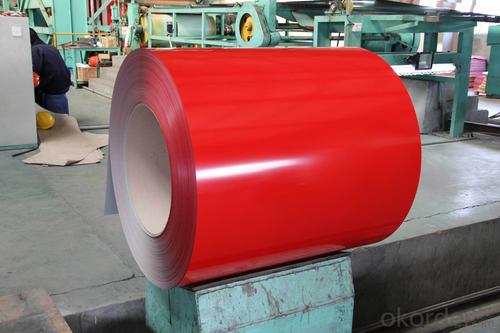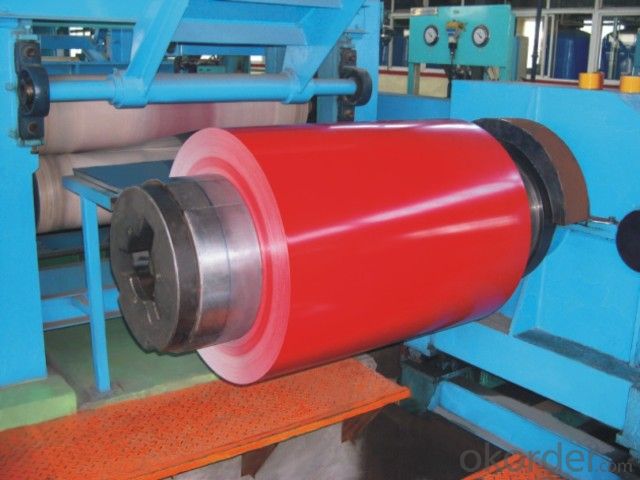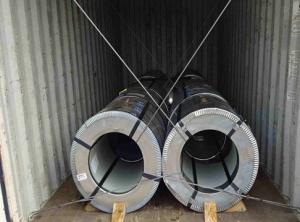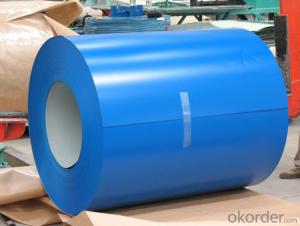Prepainted gavalume steel coil and sheet
- Loading Port:
- Tianjin
- Payment Terms:
- TT OR LC
- Min Order Qty:
- 50 m.t.
- Supply Capability:
- 10000 m.t./month
OKorder Service Pledge
OKorder Financial Service
You Might Also Like
Packaging & Delivery
| Packaging Detail: | seaworthy expot package |
| Delivery Detail: | on request |
Specifications
1.10 year's experience
2. advanced coating equipment
3.competitive price
4.soonest delivery
5.various color
Colorful ppgi prepainted galvanized steel coil
PPGI 0.16-0.6mm 700-1250mm various color/
10 year's experience /SGS
Product Description :
| Raw material | SGCC, SPCC, DC51D, SGHC,A653 |
| Certificate | ISO9001.ISO14001.OHSAS18001 |
| Thickness | 0.16mm-0.7mm |
| Width | 1250mm or under |
| Tolerance | thickness+/-0.01mm |
| Surface treatment | galvanized / galvalumized steel sheets |
T Bending (top-coating) T Bending (back-coating) | ≤3T ≤4T |
| Anti-MEK Wiping | ≥100times |
| Zinc coating | 40-180g |
| Type of coating structure | 2/1 or 2/2 coating, or customized |
| Standard | GB/T12754-2006, GB/T9761-1988, GB/T9754-1988, GB/T6739-1996, HG/T3830-2006, HG/T3830-2006, GB/T1732-93, GB/T9286-1998, GB/T1771-1991, GB/T14522-93 |
| Color | customized |
| Application | Building industry ,structural use, roofing, commercial use ,household appliance,industry facilities,office buildings |
Our advantage :
1. Expertise:
10 years of manufacture: we know how to properly handle every step of production.
2. Competitive price:
We produce resin and paint by ourself, which greatly reduce our cost!
3. Accuracy:
We have a technician team of 40 people and a QC team of 30 poeple, ensure our products is exactly what you want.
4. Materials:
All color Steel Sheets are made of high-quality raw materials.
5.Certificate:
Our products are certified by TUV, ISO9001:2008,ISO14001:2004 etc.
6. Productivity:
We have three large-scale production line, to guarantee all your orders will be finished in earlist time
- Q: Can steel coils be welded together?
- Indeed, it is possible to weld steel coils together. The practice of welding is widely employed in the fusion of metals, including steel coils. It entails the melting of the coil edges and their subsequent amalgamation with a filler material. This procedure generates a sturdy and long-lasting bond between the coils, enabling their unification into a singular entity. The act of welding steel coils together is frequently carried out across a range of industries, such as manufacturing, construction, and automotive, in order to fabricate larger structures or components. However, it is crucial to adhere to proper welding techniques and implement stringent quality control measures to guarantee the integrity and potency of the weld joint.
- Q: How are steel coils used in the production of steel wire?
- Steel coils are used in the production of steel wire by being unwound and fed into a wire drawing machine. The coils provide a continuous and consistent supply of steel, which is passed through a series of dies to reduce its diameter and increase its strength. This process is repeated multiple times until the desired wire diameter is achieved.
- Q: 911 conspiacy theorists. Can fire melt steel?
- Don't know the differences in steel strength between the WTC towers and the bridge, but I'll tell you they don't always use the strongest steel in buildings. It is a question of value engineering. Engineers do as code requires, and make the determination based on economics of building. If a steel member requires say 48 KSI, with certain span, but if the price is less expensive to use 35 KSI and reduce the span by adding vertical elements then that is an option that the architects, engineers and developers consider. Like I said, don't much about bridge engineering, but in buildings, it isn't always the strongest steel, based on engineering and economics. And BTW, said time and time again, but ok one more time. STEEL DOESN'T NOT HAVE TO MELT FOR FAILURE. IT LOSES STRENGTH WITH HEAT. THAT IS WHY IT MUST BE PROTECTED BY FIRE RETARDANT. BUT IF THE FIRE RETARDANT IS REMOVED BY EXPLOSION, THEN FIRE CAN CAUSE FAILURE. Sorry for the shouting, but I'm not the only one who says that, but people keep saying steel can't melt, but it doesn't have to for failure. If the steel joist had been in concrete, the WTC towers may have stood, at least longer. But hindsight is 20/20.
- Q: I am currently writing a manuscript, and would like to know whether guns made out of steel, burn or melt when exposed to flames. Thanks.
- Any steel will burn in the Presence of pure oxygen and high heat, that's how a cutting torch works.
- Q: What are the different types of steel coil recoiling methods?
- There are several different types of steel coil recoiling methods, including oscillating recoiling, flying shear recoiling, and rotary recoiling.
- Q: What is the average width tolerance for steel coils?
- The average width tolerance for steel coils can vary depending on the specific requirements and standards set by the industry. However, a common range for width tolerance in steel coils is typically around ±0.005 to ±0.030 inches.
- Q: How are steel coils packaged for shipment?
- Steel coils are typically packaged for shipment by being tightly wound and secured with steel bands or straps. They are often placed on wooden skids or pallets to provide stability and protection during transportation. Additionally, protective covers or sheets may be used to shield the coils from moisture and other potential damages.
- Q: How are steel coils used in the production of shipbuilding materials?
- Steel coils are used in shipbuilding materials as they provide a versatile and durable solution. They can be processed into various shapes and sizes, including plates, beams, and sections, which are essential components for constructing ships. The coils are often cut and shaped to fit specific design requirements, offering strength and structural integrity to the ship's framework. Additionally, the coils are utilized in the fabrication of various shipbuilding components, such as hulls, decks, bulkheads, and superstructures, ensuring the vessels' resilience and stability.
- Q: How do steel coils contribute to the manufacturing of steel furniture?
- Steel coils play a crucial role in the manufacturing of steel furniture. These coils, which are made of high-quality steel, serve as the primary raw material for the production of various furniture items. Firstly, steel coils are used to create the framework and structure of steel furniture. These coils can be easily cut, shaped, and welded into various shapes and sizes, allowing manufacturers to create sturdy and durable furniture frames. The flexibility of steel coils enables the production of furniture with intricate designs and unique shapes, providing both functional and aesthetic value. Additionally, steel coils are also used in the production of springs for furniture such as sofas and chairs. The elasticity and strength of the steel coils make them ideal for creating comfortable and supportive seating options. These coils are carefully formed and integrated into the furniture, ensuring that the seating surface provides the necessary resilience and flexibility for a comfortable experience. Moreover, steel coils contribute to the overall durability and longevity of steel furniture. Steel is known for its high tensile strength and resistance to wear and tear, making it an excellent choice for furniture that is subjected to heavy use and weight load. The use of steel coils ensures that the furniture can withstand years of regular use without compromising its structural integrity. Furthermore, steel coils are often treated with various finishes and coatings to enhance their appearance and protect them from corrosion. These coatings can be applied to the coils before they are shaped into furniture components, ensuring that the final product maintains its aesthetic appeal and remains resistant to rust and other forms of damage. In conclusion, steel coils are an essential component in the manufacturing of steel furniture. They provide the necessary strength, flexibility, and durability required to create sturdy furniture frames, comfortable seating surfaces, and long-lasting products. Without steel coils, the production of steel furniture would not be possible, and the quality and performance of the final products would be compromised.
- Q: I have a knife with 154cm steel on it and I always here that you should put oil on it to keep it from rusting but I am just wondering what kind of oil? And how do I apply it and do I just leave it on there?
- If the knife is stainless steel, then you don't have to worry about it rusting, unless you leave it sheathed in a wet sheath. Be sure you clean it off before folding it up or re- sheathing it. For carbon steel blades, almost any good household oil will work. 3 in 1, Rem oil, etc.
Send your message to us
Prepainted gavalume steel coil and sheet
- Loading Port:
- Tianjin
- Payment Terms:
- TT OR LC
- Min Order Qty:
- 50 m.t.
- Supply Capability:
- 10000 m.t./month
OKorder Service Pledge
OKorder Financial Service
Similar products
Hot products
Hot Searches
Related keywords




























